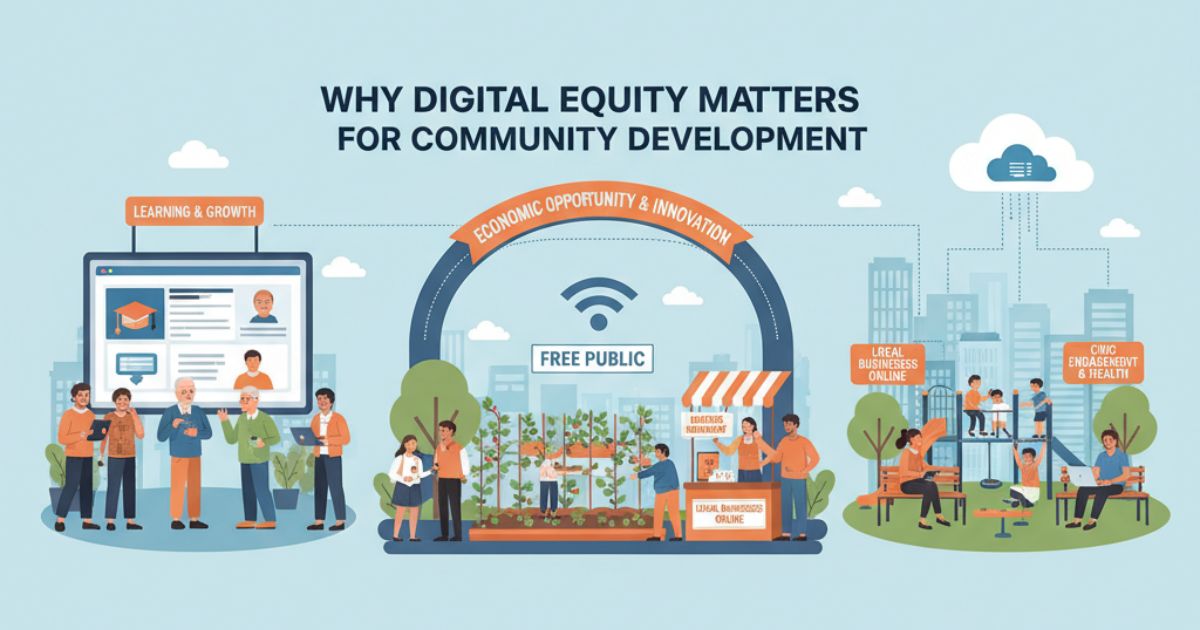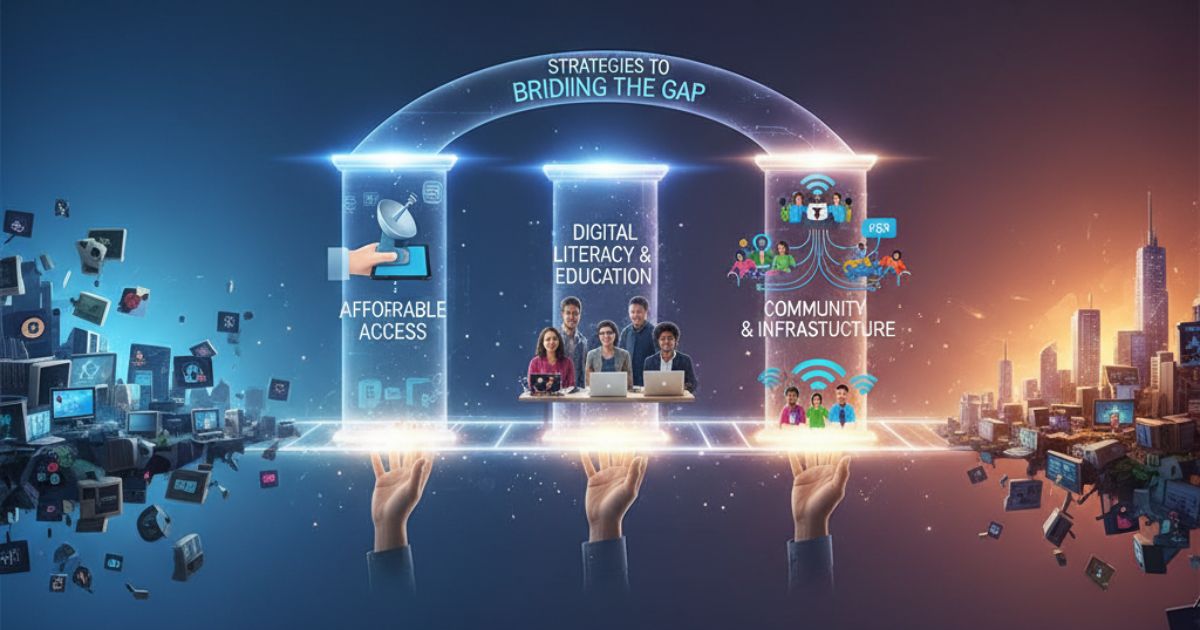Access to reliable internet and digital tools has become a basic need, not a luxury. Digital equity ensures that everyone, regardless of income, education, or location, can fully engage in modern life. Yet millions of people remain affected by the digital divide, unable to benefit from technology access or online opportunities. Many individuals face barriers, including poor internet connectivity, limited digital literacy, and the high cost of devices. These challenges widen social and economic gaps within communities. Achieving digital inclusion is essential for stronger education, better jobs, and improved public services. By investing in digital equity, community leaders can drive inclusive growth and sustainable community development.
Understanding the Digital Divide
The digital divide refers to the gap between individuals and communities that have access to modern technology and those that do not. It appears in three key areas: infrastructure, affordability, and digital literacy. Limited broadband connectivity prevents many rural regions from going online. In cities, low-income families often face high costs for devices and data plans. Others may struggle with the skills needed to use technology effectively. These barriers are profoundly connected and reinforce one another. To achieve accurate digital equity, communities must address all three challenges. Recognizing how access, cost, and skills interact helps create inclusive, sustainable solutions that promote digital inclusion for everyone.
Why Digital Equity Matters for Community Development

Digital equity creates pathways for inclusive economic opportunity and long-term community development. When residents have equal online access, they can apply for jobs, participate in online training programs, and grow their small businesses through e-commerce platforms. In schools, reliable internet connectivity enables students to complete lessons, participate in virtual classrooms, and access digital learning materials. Telehealth services enable patients to consult with doctors remotely, without the need to leave home. Civic engagement also improves when people can attend virtual meetings and use digital government services. During natural disasters or health emergencies, quick digital communication keeps communities informed and safe. Building digital inclusion is not just about technology—it is about creating resilient, connected, and empowered communities.
Key Challenges in Achieving Digital Equity
- Infrastructure Gaps: Remote and low-density areas frequently lack access to fiber, cable, or cellular coverage.
- Affordability Barriers: High costs of broadband subscriptions and up-to-date devices put connectivity out of reach for many.
- Digital Literacy Deficits: Without training, even those with internet access may not fully benefit from online services.
- Cultural and Language Barriers: Non-native speakers and marginalized groups may face challenges in accessing online content.
- Trust and Privacy Concerns: Fears about data security and surveillance can deter users from engaging.
Strategies to Bridge the Digital Divide


1. Investing in Infrastructure
Local governments, utility companies, and internet service providers (ISPs) must collaborate to expand broadband networks. Public funding initiatives, such as grants and low-interest loans, can encourage ISPs to expand their fiber and 5G networks in underserved areas. Community mesh networks, where residents share bandwidth, offer a decentralized alternative in regions where commercial deployment isn’t yet profitable. Prioritizing open-access infrastructure ensures that multiple providers can provide services, driving competition and lowering costs.
2. Promoting Digital Literacy
Community centers, libraries, schools, and nonprofits can host free workshops that teach essential skills, such as setting up email accounts, navigating online job portals, or using telehealth platforms. Peer-to-peer mentoring programs pair tech-savvy volunteers with seniors or low-literate adults. Mobile training labs—vans equipped with laptops and Wi-Fi hotspots—can travel to remote or marginalized neighborhoods. By empowering individuals with confidence and competence, digital literacy programs unlock the full potential of connectivity investments.
3. Fostering Public-Private Partnerships
No single stakeholder can close the digital divide on their own. Successful initiatives unite municipal governments, ISPs, educational institutions, and community-based organizations. For example, a city may provide subsidized pole attachments for fiber deployment, while libraries supply training trainers, and tech companies donate equipment. These partnerships leverage complementary resources and expertise, reducing duplication of effort and maximizing impact.
4. Designing Inclusive Policies
Policymakers should adopt a digital-first approach, embedding connectivity considerations into housing, transportation, and economic development plans. Universal Service Funds (USFs) or dedicated broadband levies can finance connectivity for low-income households. Zoning regulations might require new housing projects to include a conduit for fiber or wiring for Wi-Fi. Transparent, community-involved policy design ensures that the unique needs of diverse neighborhoods are addressed.
5. Subsidizing Devices and Data Plans
While broadband availability is critical, having a connection is meaningless without a capable device. Voucher programs can help low-income families purchase laptops or tablets at reduced rates. Partnering with telecom operators to offer tiered, low-cost data packages ensures sustained access to data. Refurbished device drives, where schools or corporations donate hardware that’s professionally reset and upgraded, make technology more affordable and environmentally sustainable.
6. Developing Community-Led Digital Content
Relevance drives adoption. Local organizations can co-create multilingual, culturally sensitive digital resources—from e-learning modules to telehealth tutorials—that directly address the needs of their communities. Youth hackathons and design sprints can produce apps or chatbots tailored to neighborhood-specific challenges. When residents see value in online offerings, they’re more likely to invest time and effort in using them, strengthening overall digital inclusion.
Case Studies of Digital Inclusion in Action
Rural Broadband Cooperatives
In several states, cooperative models have emerged where farmers, local businesses, and residents pool resources to build and manage their own broadband networks. By leveraging federal grants and community fundraising, these cooperatives have delivered high-speed internet to areas previously overlooked by major ISPs, demonstrating that grassroots initiatives can succeed where market incentives falter.
Community Tech Hubs
Urban neighborhoods in cities like Detroit and Philadelphia have transformed vacant storefronts into tech hubs, offering co-working spaces, 3D printers, and coding boot camps. These multipurpose centers serve as digital empowerment zones, where residents can access free Wi-Fi, learn new skills, and launch local startups, creating a ripple effect in employment and civic engagement.
The Role of Stakeholders and Partnerships
Libraries, schools, faith-based organizations, and nonprofits are at the forefront of efforts to promote digital equity. They identify local needs, mobilize volunteers, and deliver training. Telecom companies possess the technical expertise and infrastructure, while policymakers control funding and regulatory levers. Aligning incentives through memorandums of understanding (MOUs) and data-sharing agreements ensures accountability and sustained collaboration. Engaging residents in decision-making fosters trust and tailors solutions to the community’s real-world context.
Measuring Success and Ensuring Sustainability
Quantitative KPIs—such as percentage of households with broadband, number of devices distributed, and workshop attendance rates—offer a baseline view of progress. Qualitative metrics, including user satisfaction surveys and case narratives, capture more profound insights into how connectivity transforms lives. Regular monitoring, transparent reporting, and iterative refinement keep programs on track and responsive to evolving challenges. To sustain gains, communities should establish governance bodies or steering committees that oversee ongoing initiatives beyond single funding cycles.
Future Outlook for Digital Equity
Emerging technologies, such as low-Earth orbit (LEO) satellites, promise to bring affordable broadband to the most remote corners of the globe. Artificial intelligence-driven learning platforms can personalize digital literacy curricula on a large scale. Blockchain-based digital identity solutions may enhance trust and privacy in online services. Yet technology alone is not a panacea. A human-centered approach—grounded in collaboration, inclusion, and respect for local culture—will determine whether these innovations truly bridge the digital divide or inadvertently widen new gaps.
Conclusion
Bridging the digital divide is more than a technical challenge; it’s a mission to build stronger, more equitable communities. By investing in infrastructure, fostering digital literacy, forging partnerships, and designing inclusive policies, stakeholders can unlock the full potential of connectivity for everyone. Success demands sustained commitment, robust measurement, and active resident engagement. As we close the connectivity gap, we pave the way for economic growth, educational achievement, and civic empowerment, ensuring that no community is left behind in the digital age.





